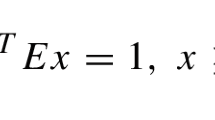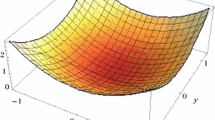Abstract
This paper describes a symmetric duality relation for quasi-convex programs. We are able to strengthen previous results and to define necessary and sufficient conditions for the absence of duality gap. In the present scheme one can generate quasi-convex quasi-concave Lagrangians and discuss the correspondence between saddle points of the Lagrangians and the solutions to the dual and primal programs. The present scheme is very similar to Rockafellar's scheme for convex programs and in this sense it may be viewed as a unified approach. Several examples are also given.
Similar content being viewed by others
References
A. Charnes and W. Cooper, “Programming with linear fractional functionals”,Naval Research Logistics Quarterly 9 (1962) 181–186.
J.P. Crouzeix, “Contribution a l'étude des functions quasiconvex”, Thesis, Université de Clermont II (France, 1977).
J.P. Crouzeix, “A duality framework in quasi convex programming”, in: S. Schaible and W.T. Ziemba, eds.,Generalized concavity in optimization and economics (Academic Press, New York, 1981) pp. 207–225.
W. Fenchel, “A remark on convex sets and polarity”, Communication Seminar on Mathematics, University of Lund Supplementary volume (University of Lund, Lund, 1952), 22–89.
J. Flachs and M.A. Pollatschek, “Duality theorems for certain programs involving minimum or maximum operators”,Mathematical Programming 16 (1979) 340–370.
H.J. Greenberg and W.P. Pierskalla, “Quasi-conjugate functions and surrogate duality”,Cahiers du Center d'Etudes de Recherche Opérationnelle 15 (1973) 437–448.
H.J. Greenberg and W.P. Pierskalla, “Surrogate mathematical programming”,Operations Research 18 (1970) 924–939.
H.J. Greenberg, “The generalized penalty function — surrogate model”,Operations Research 21 (1977) 162–178.
H.J. Greenberg and W.P. Pierskalla, “A review of quasi-convex functions”,Operations Research 19 (1971) 1553–1570.
V.L. Klee, “Maximal separation theorems for convex sets”,Transactions of the American Mathematical Society 134 (1968) 133–148.
D.G. Luenberger, “Quasi-convex programming”,SIAM Journal 16 (1968) 1090–1095.
U. Passy and E.Z. Prisman, “Conjugacy in quasi convex programming”,Mathematical Programming 30 (1984) 121–146 (also Mimeograph Series No. 297, Faculty of Industrial Engineering and Management, Technion, Haifa, Israel, 1981).
U. Passy and E.Z. Prisman, “Saddle-functions and min-max problem. The quasi-convex quasiconcave case”, Mimeograph Series No. 299, Faculty of Industrial Engineering and Management, Technion (Haifa, Israel, 1981).
E.Z. Prisman, “A new approach to duality Lagrangians and saddle functions in quasi convex programming”, Thesis, Technion (Haifa, Israel, 1981).
R.T. Rockafellar,Convex analysis (Princeton University Press, Princeton, NJ, 1970).
R.T. Rockafellar, “Polyhedral convex sets with some closed faces missing” (unpublished manuscript).
I. Singer, “Optimization and best approximation”, Proceeding of the Seventh International Summer School, Berlin, 1979 (Academie-Verlag, Berlin, 1981).
I. Singer, “Optimization by level set method IV: Generalization and complements”, Technical report 0250-3638, Department of Mathematics, National Institute for Scientific and Technical Creation (Bucharest, Romania, 1982).
I. Singer, Private communication (May 1983).
J. von Neumann, Uber ein ökonomisches Gleischungsystem und eine Verallgemeinerung des Brouwerschen Fixpunktsatzes”, in: K. Menger, ed., Ergebnisse eines mathematischen Seminars (Vienna, Austria, 1938).
Author information
Authors and Affiliations
Rights and permissions
About this article
Cite this article
Passy, U., Prisman, E.Z. A convex-like duality scheme for quasi-convex programs. Mathematical Programming 32, 278–300 (1985). https://doi.org/10.1007/BF01582050
Received:
Revised:
Issue Date:
DOI: https://doi.org/10.1007/BF01582050




